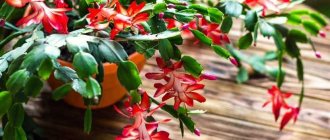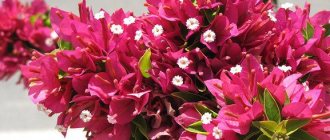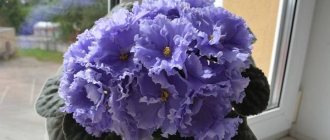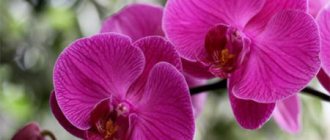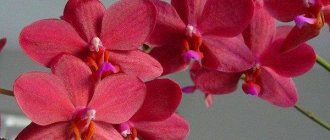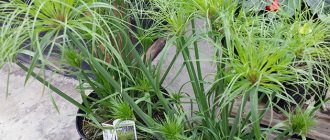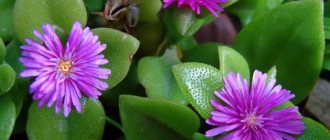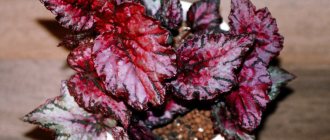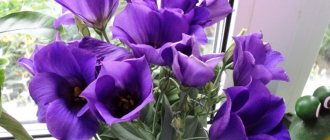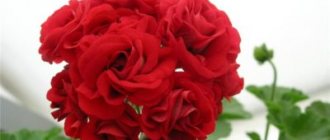Easily recognizable and original indoor plants belong to the Bromeliad family. These are one of the leaders in home floriculture, not always unpretentious, but always extravagant. Outlandish colors of powerful hard leaves, unusual inflorescences and the status of a daring exotic are inherent in all bromeliad beauties. With one exception: it is difficult to guess whether the relatively modest Billbergia nutans . This plant seems more like a cereal, but it has its trump cards. The modest billbergia with amazing grace has a harmonizing effect on the interior and, due to its care requirements, can rightfully be called an unpretentious plant.
Billbergia nutans
Briefly about bromeliads
You may be interested in: Clematis Omoshiro: growing at home
It would seem like one family, but such different plants belong to it! For example, a pineapple - it also belongs to the bromeliad family. And to look at him and the drooping Billbergia (photo below) - well, nothing in common!
You may be interested in:Anthurium has brown spots on the leaves: what to do with the flower, methods for solving the problem and care tips
However, this is only at first glance. In fact, all representatives of bromeliads have common features by which you can immediately recognize “one of your own”. This is the very dense texture of the leaves, as well as the shape in which they are collected - in the form of a funnel. In it, such plants accumulate water; a similar ability arose in them during the process of evolution after dry periods.
There are more than three thousand bromeliads; they are divided into lithophytes (terrestrial) and epiphytes (plants that settle on other plants, but they are not parasites, they simply survive in this way - they cannot do otherwise due to a weak root system). Along with pineapple and some other representatives of the bromeliad family, Billbergia drooping is one of the most common indoor plants.
Useful properties of Billbergia
Bilberg is fading. Photo
Billberg leaves actively release phytoncides, which effectively disinfect the air. This plant is also able to enhance the negative ionization of air, thereby creating beneficial electrostatics. In addition, it actively promotes sound absorption. Its attractive appearance makes it an excellent decoration for any type of interior.
Short description
Billbergia is an epiphyte, meaning it lives on other plants. In the wild, it prefers to live in tropical rainforests. Like other bromeliads, it is a herbaceous perennial, but in all other respects it is a completely atypical representative of the family. But it is very unpretentious - caring for drooping Billbergia is absolutely easy, and perhaps that is why they are so fond of purchasing it to decorate their home. By the way, it is believed that Billbergia brings harmony to the home.
You may be interested in:Hydroponics at home: necessary equipment, tips for growing and caring for plants
Billbergia drooping also differs from other plants in that it blooms not in the summer, like the vast majority, but in the cold period - from October to January. Thus, it seems to warm its owner in the most persistent and severe frosts, giving warmth and a reminder of the hot, colorful summer.
Appearance
Like other members of the family, the Billbergia flower has dense leaves collected in a funnel. At the same time, in other respects, the leaves of this plant are noticeably different from the leaves of other bromeliads: in Bilbergia they are narrow, long and seemingly pointed. To the touch they are covered with scales, and on the sides - as if with thorns. Some are the same color, and some are different (and we are still talking about the leaves, and not about the flowers themselves). As for the flowers, or inflorescences, they, as is clear from the name of the plant itself, are drooping, that is, with their “heads” lowered. At the same time, they seem to be twisted into a small tight spiral, reaching twenty to thirty centimeters. Their color is very unusual and original - dove-blue at the edges, towards the center it turns into yellow-green-pink. The bracts of Billbergia drooping (or drooping, by the way) are very beautiful: bright fuchsia color.
Billbergia is quite small in size - half a meter maximum in height. But it grows greatly in width, which is why it gives the impression of a huge bush.
Types of Billbergia with photos
The most common types of Billbergia found in indoor culture are those described below.
Billbergia nutans
The length of the belt-shaped bright green leaf plates reaches about 0.7 m. In intense lighting, the leaves acquire a pinkish tint. The large leaf rosette has a tubular shape. Drooping inflorescences are decorated with long bracts.
Billbergia pallidiflora
This species is found in nature on rocky slopes. A tubular power socket consists of a small number of sheet plates. Along the edge of the hard, rich green leaves there are a large number of thorns. At the top of the curved peduncle, a spike-shaped inflorescence with dense pubescence is formed.
Billbergia magnifica
A powerful tubular rosette is assembled from a small number of leaf plates. The length of the green linear leaves can reach up to 0.7 m. The spike-shaped inflorescence is collected from blue flowers. The bracts are large and pink.
Zebra-shaped Billbergia, or Zebrina (Billbergia zebrina)
The long leaf blades, leathery to the touch, are decorated with white stripes. During flowering, blue flowers and large pink bracts appear.
Origin story
Billbergia was first discovered in the eighteenth century, and this discovery was made by a Swedish scientist, botanist named Billberg. While traveling through the forests of Central and South America, Gustav Billberg noticed an unusual, never-before-seen plant of amazing beauty. Billbergia, described by the scientist in his diary, was brought to Europe, and from there it began its victorious march around the world. A little later, it received its name - of course, after the name of its discoverer. By the way, Bilbergia also has, so to speak, a popular name - “queen’s tears.” The thing is that the flower secretes nectar, which drips from the drooping inflorescences of the plant like real tears. Initially, breeding Billbergia was available only to the wealthy segments of the population and was very fascinating to them. Now everyone can grow this flower on their windowsill.
Billbergia drooping: home care
You may be interested in: Pineapple in a pot: planting, care, watering features, photo
It has already been said above that the plant we are interested in is extremely unpretentious, and this is true. It is also very loyal and will easily forgive its owner for small mistakes in taking care of itself, so it is perfect for beginning amateur flower growers. This is a very hardy plant, and even super-busy people with tight work schedules who are not able to devote much time to the flower will be amazed at how quickly this beauty will bloom for them. An important point: Billbergia perfectly adapts to any living conditions, to any climate, so it can be grown both in the Kuban and in cold Siberia.
Next, let's talk about how to properly care for this tropical flower.
How to grow
We are accustomed to the fact that all indoor plants live in decorative pots, and this is logical. However, we should not forget that Billbergia is an epiphyte that settles on other trees, as well as just snags. Therefore, you can grow this flower on the so-called bromeliad tree - in other words, on a large branched snag. It’s not difficult to place a billbergia there: you just need to pull the flower out of the pot, clean the roots from the soil, wrap it in sphagnum moss, and then tie it to a snag. There is only one downside to this arrangement - the tree is still quite impressive in size, so the room where it will be located must be quite spacious. However, this drawback can be circumvented: in small rooms, instead of wood, a small block of wood is simply attached to the wall. It looks quite impressive, and caring for Billbergia in this case comes down solely to maintaining the proper moisture content of the moss.
Lighting
When it comes to lighting, Billbergia definitely outperforms any other plants - the thing is that, in general, it doesn’t care at all what light conditions it grows in. She is equally pleased to live both on a sunlit window sill and in the depths of the apartment, where natural light barely penetrates.
However, like any other plant, Billbergia drooping has its own preferences. This is diffused light with shading from the midday sun. To achieve such lighting, it is best to place the flower on windows on the east and/or west side.
Varieties
The Billbergia plant comes in different types. There are many of them. The most popular types are the following.
drooping
The leaves of this variety reach up to 70 cm in length, have a belt-shaped shape and a bright green tint. They tend to turn pink when exposed to sunlight. The foliage is collected in a tubular rosette. The inflorescences have a drooping appearance and long bracts.
It blooms in winter, which is why this species is often called a Christmas flower.
Pale-flowered
In the wild, this species grows on rocky slopes. Its leaves are few in number, collected in a tubular rosette. They are bright green in color and have many spines along the edges. The peduncle has a curved shape. Its inflorescences look like spikelets.
Gorgeous
This variety also has small leaves, but they are very long - up to 70 cm, and their width can reach 8 cm. The foliage is collected in a rosette and almost always stands straight. It is dense, has spikes along the edges and a sharp top. The leaves are scaly on top.
Zebra-shaped
This species can reach up to one meter in height. The foliage is also collected in a rosette, like other varieties. It is curved and can grow up to 70 cm and up to 8 cm wide. The leaves are linear in shape, sharp at the ends, have thorns along the edges and white scales on the surface.
Watering
Irrigation of Billbergia drooping, living in a pot, depends on the time of year. If it is summer, then a lot of water is required - so much so that the soil always remains slightly moist; however, it is important to ensure that there is no moisture stagnation. During this period, water is also sent into the funnel of the leaves. Important: after flowering, it is strictly forbidden to do this, since such an action can lead to rotting of the plant. In winter, the tropical beauty is watered less often, the soil is allowed to dry, and the leaves are left dry. Water for irrigation at any time of the year should be warm, standing for 24 hours (it is permissible to add acetic or citric acid to soften it).
If the billbergia lives on a bromeliad tree, then all that needs to be done is to remove the moss when it is completely dry and immerse it in a container of water for about twenty minutes. After this time, the moss is pulled out, excess moisture is allowed to drain and the sphagnum is returned to its place.
general information
- Origin: Argentina, Brazil and Uruguay.
- Height: 37.5 cm high
- Plant type: House plant; epiphytes and terrestrial species
- Mature size: Depends on species
- Sun exposure: Bright indirect light
- Soil Type: Fast Draining Soil Mix
- Soil pH: 5 to 6
- Flowering time: Blooms once; times vary
- Flower Color: Red, Green, Purple, Orange, Yellow
The foliage can be up to 12 inches tall and about twice as wide, so give your Bilbergia plant some room to spread. Its thick, striped leaves curve into a fountain shape, making this tropical beauty an elegant accent houseplant.
You can expect flowers in the spring when the plant reaches maturity, usually in 2-3 years. Bilbergia flowers are pink, purple, yellow or green, surrounded by red or pink bracts. Billbergia nutans gets one of its common names from the nectar drops that “cry” from the flowers when the plant is touched.
Most are epiphytes in their natural habitat. Often found on tree branches in tropical forests of South America. They have small roots that are mainly used to anchor themselves to trees, so these woody plants collect moisture and nutrients through their leaves.
Temperature and humidity during care
Billbergia loves warmth, but not heat. During the active period, you need to make sure that the room is warmer - within 25-28 degrees, during the rest period - cooler, from 15 to 18 degrees. The latter is a must, since it is the coolness that stimulates the development of the kidneys. However, you should not be zealous and lower the temperature too much: Billbergia nutans (this is the Latin name of the flower) may get sick and die.
Air humidity should be maintained between 70-80 percent. If it’s summer outside or the room is always hot and dry, the flower should be sprayed regularly (except for the flowering period). If the plant lives in a pot, you can place the flowerpot on a tray with water.
How to care for indoor Billbergia
Billbergia flower photo
Air temperature, humidity and lighting
Compared to other plants of the Bromeliad family, Billbergia is less demanding in care. It tolerates dry air more easily, can withstand air temperatures of + 2-3 ° C, small drafts will not destroy it, but it is still not worth overusing. Grows well in greenhouses and terrariums.
Lighting needs to be bright and diffused. On southern windows at midday, shade from direct sunlight - just cover the window with translucent paper. When placed on a north window, it may not bloom. The best place would be windows facing west and east.
You can place it outdoors for the whole summer, protecting it from direct sunlight or precipitation.
The optimal air temperature in the summer season is in the range of 20-28 °C. By autumn, lower to 18 °C. During the dormant period (October-February), an air temperature of about 15-17 °C is desirable for forms with green leaves, and 17-18 °C for variegated plants. Cool wintering stimulates flowering.
Watering and spraying
In the summer, regularly moisten the substrate, avoid overmoistening. You can use bottom watering or pour water into leaf funnels, but the air temperature should be above 20 ° C and the water should not stagnate. Prolonged stagnation of water combined with low air temperature leads to rotting or even death of the plant.
With the epiphytic method of cultivation (placed on a bromeliad tree), once every 10 days the plant should be removed from its support and immersed in settled water to saturate. Let the excess water drain, then return the billbergia to its place.
In autumn-winter, when the air temperature is below 20 ° C, water moderately, allowing the top layer of soil to dry out. If the air temperature is above 20 °C, you can occasionally pour a small amount of warm water into the leaf funnel.
Billbergia can tolerate dry air, but it is better to maintain high humidity. Spray a couple of times a day, periodically place on a tray with damp expanded clay, moss, and pebbles. It is better not to spray during the flowering period - drops of water falling on the inflorescences may remain stained.
Feeding
During the period of active growth, every 2 weeks apply special fertilizers intended for Bromeliads or fertilizers for decorative flowering indoor plants in half the concentration. Avoid excess nitrogen.
Transfer
Flowering species must be replanted annually after flowering, the rest - as needed.
Grows well in hydroponics. It is best to grow in a special substrate for Bromeliads. A suitable soil mixture will be: mix turf, leaf, humus soil, peat in equal proportions, add a little sand. You can mix chopped moss, leaf soil, peat, sand in a ratio of 2:2:1:1.
Use a wide, but not deep, pot. After planting, it is necessary to water moderately for 2-3 weeks and postpone the application of fertilizers.
Feeding
What other care is needed for Drooping Billbergia at home? In the photo you can see beautiful, pleasing flowers. This result can be achieved if you feed the southern guest correctly and in a timely manner. This should be done exclusively during the growing season.
Once every fourteen days at this time, you should supply the flower with fertilizers for bromeliads; similar ones for orchids are also suitable, but in half the dose. The main thing is that the fertilizing contains a minimum of nitrogen, since too much nitrogen can lead to the death of the plant.
Varieties
The most common types of Billbergia among amateur gardeners are:
Bilbergia nutans (Bilbergia drooping, see photo), or “Tears of the Queen” is a plant 35-40 cm high, with a rosette of leaves and a drooping peduncle that can reach 80 cm in length. The flowers are half-open, greenish-purple in color with bright pink bracts. This is not the only Birbergia variety with sad, drooping beautiful “crying” inflorescences - this is its originality.
Billbergia magnifica (magnificent billbergia, see photo) is a plant native to Southeast Brazil. It has erect, hard, rosette-shaped leaves with spines along the edges and a pointed tip. The peduncle is large, up to 30 cm, drooping downwards, has large leaves and bracts. Blue petals up to 7 cm wide are twisted into a spiral. After flowering it forms berries.
Billbergia vittata (Billbergia ribbon, see photo) - is distinguished by the variegated color of its leaves - from bronze to olive, and silver stripes on their back side. The flowers of this bilbergia are bright blue, with pink bracts.
Billbergia viridiflora (green-flowered billbergia, see photo) is a large epiphytic plant native to southern Mexico. Dark green leaves with jagged edges are covered with grayish scales, smaller on the peduncle.
Billbergia zebrine (zebra billberg, see photo) is a rosette plant with a purple-bronze color with large transverse stripes. The flowers are collected in a loose pink cluster with bright pink bracts.
Billbergia saundersii (Billbergia saunders, see photo) is a small epiphytic plant with a narrow, erect rosette of leaves covered with thorns along the edges. At the tops, the leaf blades have a greenish tint with a bronze tint, at the bottom - red with an intricate pattern of dots, spots and stripes of a pink-yellow hue. The peduncle is cascading, with broad-leaf leaves and yellow-green-blue petals.
The soil
As for the soil, there are no special claims here. The main thing is that it is crumbly enough so that water and air penetrate well through it. There are special soils for bromeliads, which can also be used for planting billbergia (pictured).
Caring for it, as you can see, is not too burdensome. And in response to care and attention, the green pet will certainly delight the owner with original inflorescences.
However, let's return to the soil. According to experienced flower growers, it is also possible to prepare the soil yourself: you need to mix leaves, peat, humus in proportion, add a little chopped moss and sand. The drainage layer of the substrate must be very good.
Seeds
The most troublesome technique of all, suitable only for experienced gardeners. If at some stage you make a small mistake, the flower simply will not grow. Seeds for planting must be fresh. After collecting, they need to be soaked in potassium permanganate (a slightly diluted solution) and dried a little.
The next stage is the preparation of special containers, which are filled with a mixture of peat and wet river sand. The seeds are pressed into pre-moistened soil to a depth of about one centimeter. The boxes should be covered with film or glass. Next, they are put in a warm, dark place for five weeks. Periodically remove the film and spray the soil to maintain optimal moisture levels and control soil condition.
In divisions
The method allows you to immediately obtain large and mature plants without a waiting period. The length of leaf cuttings should be at least twenty centimeters. Such specimens quickly take root and grow actively. The cuttings are rooted in specially prepared moist soil consisting of a mixture of coarse sand and peat. Cover the container with film or glass and place it in a warm place. Spraying is carried out regularly - every 3 days. The first roots will appear in 4 weeks.
Reproduction and transplantation
Billbergia drooping has a lot of “offsprings” - branch sprouts. The easiest way to propagate a plant is with their help. You can separate them from the nodal part during transplantation, and the young shoots will bloom approximately a couple of years after rooting. Another option is to divide the adult flower; in this case, flowering can be expected as early as next year. There is a third method: seed propagation, but it is the most difficult and is suitable, perhaps, for the most patient people, since it involves following special technologies for germinating seeds and breeding the sprouts themselves.
As for replanting, this should only be done when the previous pot of Bilbergia becomes small. The thing is that the root system of the plant is not only weak, but also small and slowly developing. “Transplantation,” as a rule, is accompanied by the division of an overgrown flower, and flowerpots and other vessels for plants need to be selected in such a way that they are wide enough (and their depth is not at all necessary).
Billbergia propagation methods
In divisions
If you want to get mature and large plants that are attractive and look great without a long wait, during replanting you should not separate individual plants, but simply divide the grouped bushes into two or three parts. Large divisions will take root faster, will grow actively and, in fact, will bloom as profusely as the undivided mother plant before transplantation.
Billbergia drooping
Children who are produced in astonishing numbers
This plant is very easy to propagate, because planting material can be obtained with each transplant. Individual plants adapt less well than divisions; the process of achieving maximum decorativeness takes longer, but individual “rosettes” can become a luxurious plant after a few years. Children need to be carefully broken out; however, plants that have not grown to a level of 20 cm or higher cannot be separated.
Billbergia slices must be sprinkled with crushed coal and dried. Rooting of children will require lower heating, an air temperature of at least 20 degrees and covering with a film or cap.
Diseases and pests
Parasites such as aphids, spider mites, mealybugs and scale insects can harm Billbergia drooping. All of them can be removed quite easily with the help of insecticides, which should be used to treat the entire billbergia (an insecticide of any appropriate action is suitable).
As for diseases, drooping Billbergia is susceptible to the following misfortunes: drying of the tips of the leaves in the absence of water in the funnel, rotting of the plant due to waterlogging, and the appearance of light brown spots due to sunburn. In addition, if there is not enough light, the leaves may become too loose and their funnel will fall apart. To prevent any of this from happening, you just need to properly care for the plant.
This is information about an unusual tropical plant - drooping billbergia.
Source
Does it bloom late?
Billbergias that do not bloom do not receive enough light. Move the plant to a brighter area. Moving it outside for the summer, a partially shaded area may be just what it needs.
You can encourage flowering by adding a pinch of Epsom salt (magnesium sulfate) to water or fertilizer.
Give it a boost to bloom with this simple trick: Place a ripe apple or several apples around the plant and put it all in a clear plastic bag for a week or two.
Ripening apples release ethylene, which promotes the formation of flower buds. Keep the plant out of direct sunlight while covered in plastic to prevent overheating.
